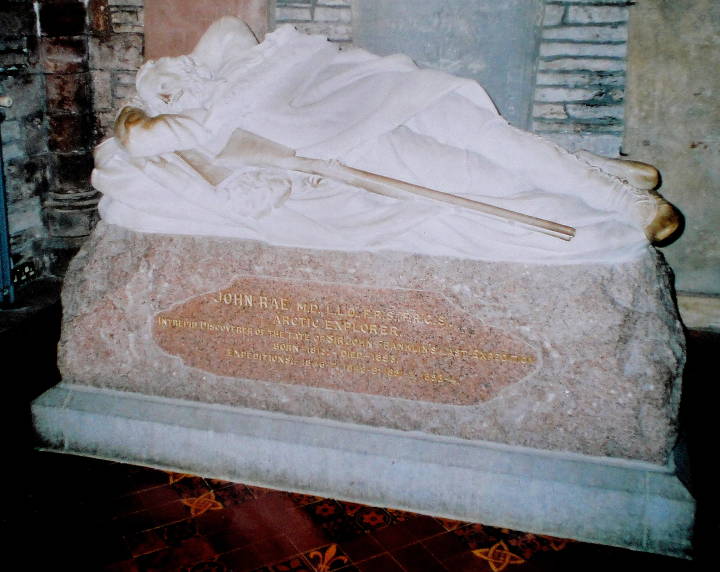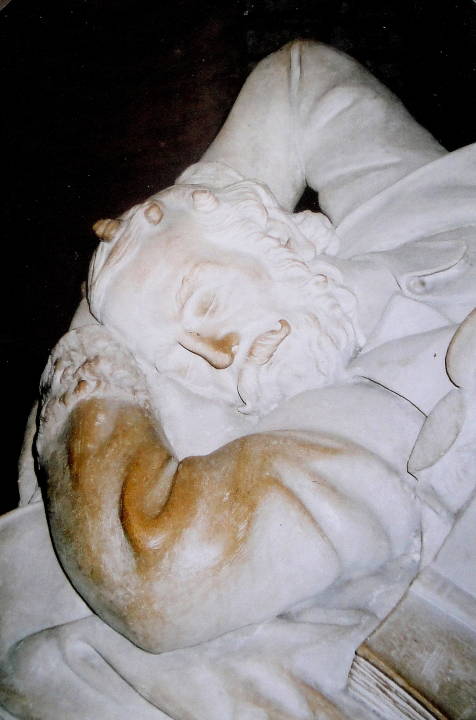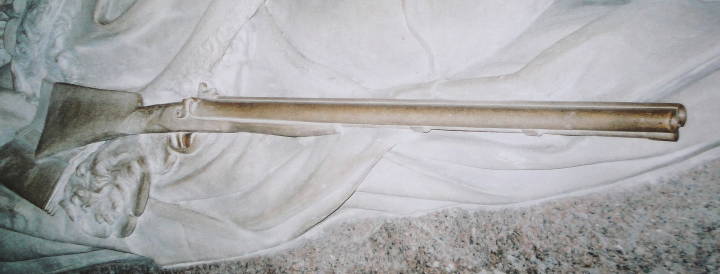

Monument to John Rae, MC, LL.D, FRS, FRGS by Joseph James Whitehead (1868-1951; active 1889-1950). St. Magnus Cathedral, Kirkwall, Orkney. [Click on images for larger pictures.] According to the Mapping Sculpture site, “Joseph was the principal sculptor associated with J. Whitehead and Son and was director of the firm by 1902. He exhibited portraits and statues at the Royal Academy of Arts between 1889-95 and had a studio in Vincent Square adjacent to premises occupied by the main family business.” This is one of his known works.
John Rae (1813-93), a Scottish physician who worked for the Hudson Bay Company, learned Inuit ways of living in the Aerctic and explored northern Canada. According to Wikipedia
He learned to live off the land like the Inuit and working with the local craftsmen, designed his own snow shoes. This knowledge allowed him to travel great distances with little equipment and few followers, unlike many other explorers of the Victorian Age.
In 1844-45, wanting to learn how to survey, Rae walked 1200 miles over two months in the winter forest, a feat that earned him the Inuit nickname Aglooka, "he who takes long strides." In 1846 Rae went on his first expedition and in 1848 joined Sir John Richardson in searching for the Northwest Passage.
While exploring the Boothia Peninsula in 1854 Rae made contact with local Inuit, from whom he obtained much information about the fate of the lost naval expedition [led” by John Franklin]. His report to the British Admiralty carried shocking and unwelcome evidence that cannibalism had been a last resort for some of the survivors.
As Wikipedia points out, “Franklin's widow Lady Jane Franklin was outraged” and encouraged well-known authors, including Dickens, to attack the Socttish physican. Wikipedia, however, incorrectly claims that Charles Dickens “wrote several pamphlets condemning Rae for daring to suggest British Naval sailors would have resorted to cannibalism." In fact, Dicken's “Lost Arctic Voyagers” explicitly defends Rae:
we will premise that we find no fault with Dr. Rae, and that we thoroughly acquit him of any trace of blame. He has himself openly explained, that his duty demanded that he should make a faithful report, to the Hudson's Bay Company or the Admiralty, of every circumstance stated to him; that he did so, as he was bound to do, without any reservation; and that his report was made public” by Admiralty: not” by him. It is quite clear if it were an ill-considered proceeding to disseminate this painful idea on the worst evidence, Dr. Rae is not responsible for it.

According to Robert Douglas-Fairhurst, recent scholarship confirms the cannibalism, though some have suggested that lead-poisoning from pioneering but primitive canned goods played an important role in the expedition's disastrous end. Rae, who grew up in the Orkneys, recognized that obvious fact that the Inuit, who had centuries of experience in the Arctic, knew more about surviving in polar conditions that did upper-class Englishmen. Typically, he was savaged by many in the English press for reporting the facts as he found them. Whereas Franklin is memorialized standing next to the Athenæum and London's most prestigious clubs — in other words, close to the center of the Empire — the truly heroic Rae found his memorial in a church far from London and in a sculpture that modestly makes no claims to heroism.
Related Materials
- An Introduction to Dickens's "The Lost Arctic Voyagers"
- The Franklin Expedition: 1845-1859
- The Search for the North-West Passage: 1497-1845
- The Lost Arctic Voyagers
- Noble's Franklin Expedition Monument
- Cannibals on the Northern Ice: Nationalist Ideals, the Big Lie, and the Franklin Expedition
Photographs and captions by Robert Freidus; commentary by George P. Landow.. [You may use this image without prior permission for any scholarly or educational purpose as long as you (1) credit the Victorian Web and (2) link your document to this URL in a web document or cite it in a print one.]
Bibliography
Douglas-Fairhurst, Robert. “Terror to Terror: How heroic lies replaced hideous reality after the Arctic death of Sir John Franklin.” Times Literary Supplement. (13 November 2009): 3-4.
Gifford, John. Highland and Islands. London: Penquin, 1992
“Joseph Whitehead.” Mapping the Practice and Profession of Sculpture in Britain and Ireland 1851-1951. Web. 3 May 2011.
Lambert, Andrew. Franklin: Tragic Hero of Polar Exploration. London: Faber, 2009.
Dickens, Charles. "The Lost Arctic Voyagers." Household Words, 2 December 1854.
"Lead solder big factor in deaths of explorers." Victoria Times-Colonist . 1 February 1990. B9.
Created 31 May 2011
Last modified 25 September 2023